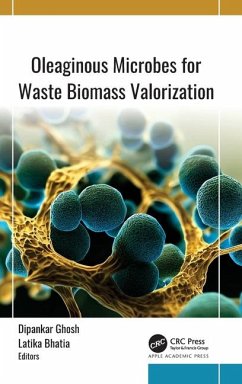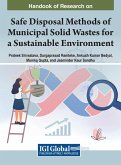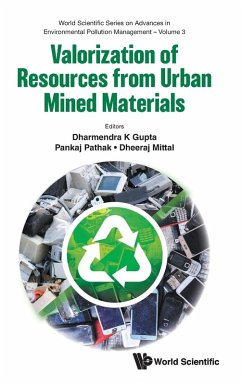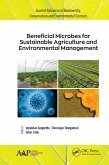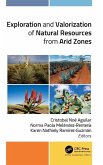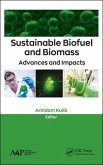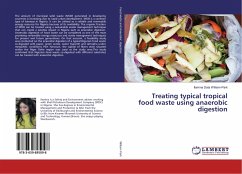Oleaginous Microbes for Waste Biomass Valorization
Herausgeber: Ghosh, Dipankar; Bhatia, Latika
Oleaginous Microbes for Waste Biomass Valorization
Herausgeber: Ghosh, Dipankar; Bhatia, Latika
- Gebundenes Buch
- Merkliste
- Auf die Merkliste
- Bewerten Bewerten
- Teilen
- Produkt teilen
- Produkterinnerung
- Produkterinnerung
Expounds on the conversion of waste materials into valuable products, such as chemicals, materials, and fuels. Discusses the innovation, design, and impact of oleaginous microbial regimes toward the utilization of waste biomass for value-added microbial products.
Andere Kunden interessierten sich auch für
![Handbook of Research on Safe Disposal Methods of Municipal Solid Wastes for a Sustainable Environment Handbook of Research on Safe Disposal Methods of Municipal Solid Wastes for a Sustainable Environment]() Handbook of Research on Safe Disposal Methods of Municipal Solid Wastes for a Sustainable Environment270,99 €
Handbook of Research on Safe Disposal Methods of Municipal Solid Wastes for a Sustainable Environment270,99 €![VALORIZATION OF RESOURCES FROM URBAN MINED MATERIALS VALORIZATION OF RESOURCES FROM URBAN MINED MATERIALS]() Gupta Dharmendra KVALORIZATION OF RESOURCES FROM URBAN MINED MATERIALS92,99 €
Gupta Dharmendra KVALORIZATION OF RESOURCES FROM URBAN MINED MATERIALS92,99 €![Beneficial Microbes for Sustainable Agriculture and Environmental Management Beneficial Microbes for Sustainable Agriculture and Environmental Management]() Beneficial Microbes for Sustainable Agriculture and Environmental Management186,99 €
Beneficial Microbes for Sustainable Agriculture and Environmental Management186,99 €![Exploration and Valorization of Natural Resources from Arid Zones Exploration and Valorization of Natural Resources from Arid Zones]() Exploration and Valorization of Natural Resources from Arid Zones199,99 €
Exploration and Valorization of Natural Resources from Arid Zones199,99 €![Fuel Production from Non-Food Biomass Fuel Production from Non-Food Biomass]() Fuel Production from Non-Food Biomass163,99 €
Fuel Production from Non-Food Biomass163,99 €![Sustainable Biofuel and Biomass Sustainable Biofuel and Biomass]() Sustainable Biofuel and Biomass159,99 €
Sustainable Biofuel and Biomass159,99 €![Treating typical tropical food waste using anaerobic digestion Treating typical tropical food waste using anaerobic digestion]() Ilamina Data William-ParkTreating typical tropical food waste using anaerobic digestion25,99 €
Ilamina Data William-ParkTreating typical tropical food waste using anaerobic digestion25,99 €-
-
-
Expounds on the conversion of waste materials into valuable products, such as chemicals, materials, and fuels. Discusses the innovation, design, and impact of oleaginous microbial regimes toward the utilization of waste biomass for value-added microbial products.
Produktdetails
- Produktdetails
- Verlag: Apple Academic Press
- Seitenzahl: 402
- Erscheinungstermin: 12. September 2025
- Englisch
- Abmessung: 240mm x 161mm x 26mm
- Gewicht: 766g
- ISBN-13: 9781774918029
- ISBN-10: 1774918021
- Artikelnr.: 73875929
- Herstellerkennzeichnung
- Libri GmbH
- Europaallee 1
- 36244 Bad Hersfeld
- gpsr@libri.de
- Verlag: Apple Academic Press
- Seitenzahl: 402
- Erscheinungstermin: 12. September 2025
- Englisch
- Abmessung: 240mm x 161mm x 26mm
- Gewicht: 766g
- ISBN-13: 9781774918029
- ISBN-10: 1774918021
- Artikelnr.: 73875929
- Herstellerkennzeichnung
- Libri GmbH
- Europaallee 1
- 36244 Bad Hersfeld
- gpsr@libri.de
Dipankar Ghosh, PhD, is an Associate Professor of Biosciences (Microbiology & Biotechnology) at JIS University, Kolkata, India. His research interests are microbial engineering and algal biotechnology. He is currently being funded for industry-sponsored research projects. He has published many peer-reviewed articles and reviews in esteemed international journals, as well as multiple book chapters. He has supervised PhD research scholars, MSc project research trainees, and internship students. Latika Bhatia, PhD, is an Assistant Professor of Microbiology and Bioinformatics at Atal Bihari Vajpayee Vishwavidyalaya, Bilaspur, India. She has 24 years of teaching experience working at universities, teaching microbiology and biotechnology to graduates and postgraduates. She has delivered many talks at national and international conferences; convened and organized conferences, seminars, and workshops; and published research articles, book chapters, monographs, and six books. She has also completed many consultancy and research projects. Dr. Bhatia is a reviewer for reputed journals and is a member of the national advisory committees of eminent universities. She has been a resource person, a keynote speaker, and a session chair at more than 20 national and international conferences, including UGC-Human Resource Development Centre short-term courses. She has received awards and honors for her work.
1. Oleaginous Microbial Regimes Towards Utilization of Waste Biomass for
Value-Added Products. 2. Significance of Oleaginous Microbes on Value-Added
Biomolecule Production. 3. Oleaginous Microbes for Industrial Waste
Degradation. 4. Significance of Process Parameter Optimization for Waste
Biomass Degradation and Valorization. 5. Valorization of Agro-industrial
Wastes for Production of Microbial Oils from Oleaginous Microbes. 6.
Oleaginous Microbes for the Production of Value-Added Products from
Agroforest Residues. 7. Valorization of Agroforestry Wastes for Bioenergy
Generation. 8. General Perspective on High Value-Added Product Generation
with Special Emphasis on NPK Biofertilizer from Oleaginous Microbes. 9.
Technological Views on Electronic Waste, Recycling, and Resource Recovery.
10. General Perspectives on Lignocellulosic Biomass-Degrading Enzymes from
Oleaginous Microbes. 11. Bioengineering of Oleaginous Microorganisms for
Biosynthesis of Fuels and Value-Added Biomolecules. 12. Scaling-Up Studies
on Lignocellulosic Waste Biomass Degradation Using the Oleaginous Microbial
System. 13. Downstream Processing Application on Waste Valorization Using
Oleaginous Microbes for NPK Biofertilizer Generation. 14. Downstream
Processing Applications on Waste Valorization for Value-Added Biomolecule
Generation.
Value-Added Products. 2. Significance of Oleaginous Microbes on Value-Added
Biomolecule Production. 3. Oleaginous Microbes for Industrial Waste
Degradation. 4. Significance of Process Parameter Optimization for Waste
Biomass Degradation and Valorization. 5. Valorization of Agro-industrial
Wastes for Production of Microbial Oils from Oleaginous Microbes. 6.
Oleaginous Microbes for the Production of Value-Added Products from
Agroforest Residues. 7. Valorization of Agroforestry Wastes for Bioenergy
Generation. 8. General Perspective on High Value-Added Product Generation
with Special Emphasis on NPK Biofertilizer from Oleaginous Microbes. 9.
Technological Views on Electronic Waste, Recycling, and Resource Recovery.
10. General Perspectives on Lignocellulosic Biomass-Degrading Enzymes from
Oleaginous Microbes. 11. Bioengineering of Oleaginous Microorganisms for
Biosynthesis of Fuels and Value-Added Biomolecules. 12. Scaling-Up Studies
on Lignocellulosic Waste Biomass Degradation Using the Oleaginous Microbial
System. 13. Downstream Processing Application on Waste Valorization Using
Oleaginous Microbes for NPK Biofertilizer Generation. 14. Downstream
Processing Applications on Waste Valorization for Value-Added Biomolecule
Generation.
1. Oleaginous Microbial Regimes Towards Utilization of Waste Biomass for
Value-Added Products. 2. Significance of Oleaginous Microbes on Value-Added
Biomolecule Production. 3. Oleaginous Microbes for Industrial Waste
Degradation. 4. Significance of Process Parameter Optimization for Waste
Biomass Degradation and Valorization. 5. Valorization of Agro-industrial
Wastes for Production of Microbial Oils from Oleaginous Microbes. 6.
Oleaginous Microbes for the Production of Value-Added Products from
Agroforest Residues. 7. Valorization of Agroforestry Wastes for Bioenergy
Generation. 8. General Perspective on High Value-Added Product Generation
with Special Emphasis on NPK Biofertilizer from Oleaginous Microbes. 9.
Technological Views on Electronic Waste, Recycling, and Resource Recovery.
10. General Perspectives on Lignocellulosic Biomass-Degrading Enzymes from
Oleaginous Microbes. 11. Bioengineering of Oleaginous Microorganisms for
Biosynthesis of Fuels and Value-Added Biomolecules. 12. Scaling-Up Studies
on Lignocellulosic Waste Biomass Degradation Using the Oleaginous Microbial
System. 13. Downstream Processing Application on Waste Valorization Using
Oleaginous Microbes for NPK Biofertilizer Generation. 14. Downstream
Processing Applications on Waste Valorization for Value-Added Biomolecule
Generation.
Value-Added Products. 2. Significance of Oleaginous Microbes on Value-Added
Biomolecule Production. 3. Oleaginous Microbes for Industrial Waste
Degradation. 4. Significance of Process Parameter Optimization for Waste
Biomass Degradation and Valorization. 5. Valorization of Agro-industrial
Wastes for Production of Microbial Oils from Oleaginous Microbes. 6.
Oleaginous Microbes for the Production of Value-Added Products from
Agroforest Residues. 7. Valorization of Agroforestry Wastes for Bioenergy
Generation. 8. General Perspective on High Value-Added Product Generation
with Special Emphasis on NPK Biofertilizer from Oleaginous Microbes. 9.
Technological Views on Electronic Waste, Recycling, and Resource Recovery.
10. General Perspectives on Lignocellulosic Biomass-Degrading Enzymes from
Oleaginous Microbes. 11. Bioengineering of Oleaginous Microorganisms for
Biosynthesis of Fuels and Value-Added Biomolecules. 12. Scaling-Up Studies
on Lignocellulosic Waste Biomass Degradation Using the Oleaginous Microbial
System. 13. Downstream Processing Application on Waste Valorization Using
Oleaginous Microbes for NPK Biofertilizer Generation. 14. Downstream
Processing Applications on Waste Valorization for Value-Added Biomolecule
Generation.

